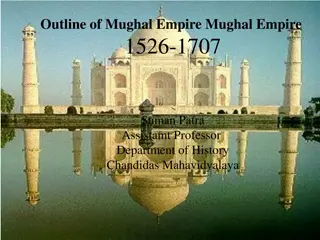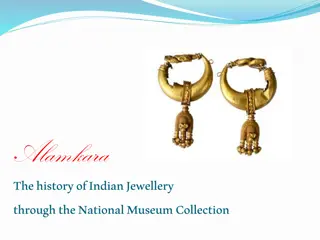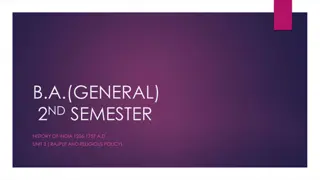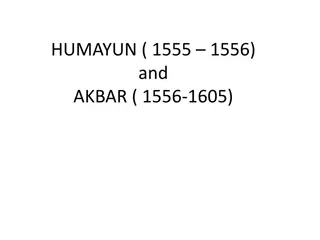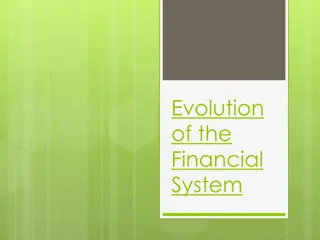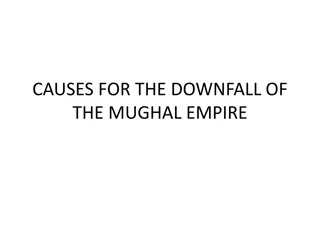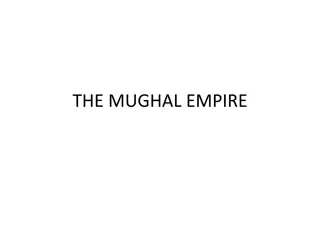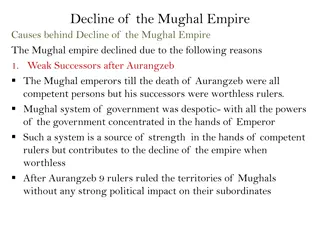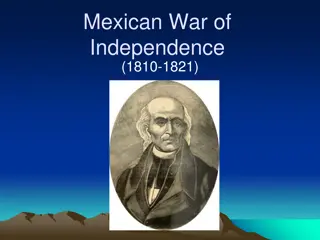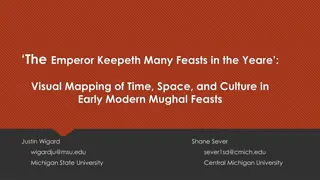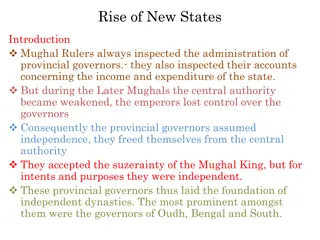Modern Period of Indian History: From Mughal Decline to Independence
The modern period of Indian history began in the 18th century after Aurangzeb's death, marked by British colonization and the struggle for independence led by key figures like Gandhi. Sources like British documents, books, and speeches provide insights into this transformative era.
Download Presentation

Please find below an Image/Link to download the presentation.
The content on the website is provided AS IS for your information and personal use only. It may not be sold, licensed, or shared on other websites without obtaining consent from the author. Download presentation by click this link. If you encounter any issues during the download, it is possible that the publisher has removed the file from their server.
E N D
Presentation Transcript
THE MODERN PERIOD By Ms Sujata Nayak [S.Scdept.] D.A.V Public School , Berhampur.
The Modern India Modern period of Indian History began in the 18thcentury after the death of Mughal Emperor Aurangzeb in 1707 A.D. The crumbling of old system gave place to new ideas and many new powers emerged on the political scene of India. With the coming of Europeans to India during this period ,India was exploited politically, socially, economically and culturally. British established East India Company as a trading company and took the advantage of the political instability and gradually took over the control of a large part of India. The 19thcentury witnessed various measures adopted by the Company to extend and consolidate its control over India like military action service , passing acts etc. The Revolt of 1857 was a major event but the colonial power suppressed it ruthlessly. In 1858 the power went in to the hands of British Crown. The discontentment against the colonial power strengthened the National Movement . The establishment of Indian National Congress in 1885 had far reaching effects. Some major events of 20thcentury were The Partition of Bengal (1905), Home Rule League, Jallianwala Bagh Massacre, etc. After a long struggle of almost 200 years , India was able to end the British Rule and gain independence in 1947 under the leadership of Mahatma Gandhi and many other national leaders. Unfortunately, India was divided into two countries India and Pakistan. , introduction of railways ,postal
SOURCES OF THE INFORMATION The things which helps in reconstructing the history are called sources eg.old buildings , inscriptions etc. Old buildings , artifacts , inscriptions , books , coins etc .helps in reconstructing the ancient and medieval period The sources of Modern India are preserved in the archives . They are- British documents Books Letters , writings , speeches etc. News papers Administrative reports of the Govt. Internet or database Old buildings , artifacts and people.
BRITISH DOCUMENTS- The records of Morle Minto Reforms of 1909 Report of the Simon Commission [1929] The Govt. of India Act 1935 The Bills like Illbert bills, Arms bills etc. They tell us the condition of the people and the administration of that time.
BOOKS- Books like-Anand Math by Bankim Chandra Chattopadhyay , My experiment with truth by Mahatma Gandhi , Unhappy Indians by Lala Lajpat Rai are an important source of information of the modern period. The poetry , prose , drama , stories , autobiographies , biographies written during this period give us an insight in to the conditions of that time.
Letters,Writings,Speeches- They provide information about the developments that take place during a particular period . Eg. Gandhi Smriti near Rajghat . Famous slogan given by Bal GangadharTilak Swaraj is my birth right , You give me blood ,I will give you freedom by Netaji Subhash Chandra Bose .
Newspapers The London Times ,Bombay Times and vernacular papers like Tilak s Kesari in Marathi , Amrita Bazar Patrika in Bengali are important sources of ndian newspapers for modern India. The British passed vernacular press Act to repress the anti-Govt. writings and propagandas . The Indian newspapers that worried the British Govt. were Somprakash , Sulabh samachar , Halisahar patrika, Amrita bazar patrika,sadharani,Bharat mihir, Dacca prakash, Bharat Sanskarak etc.
ADMINISTATIVE REPORTS Administrative reports of the Govt. on tribes , castes and land revenue settlements. Ex. report on the survey and settlement operation at Champaran (1913-19) in Bihar. Internet or Database like digital South Asia Library and the British Library s Oriental and Indian office collections provide us a lot of information.
OLD BUILDINGS,ARTIFACTS&PEOPLE The architectural style of old buildings, artifacts and people of that period tells us about modern India. Freedom fighters who saw the important changes, shared their experiences which throw light on the life of the people and the conditions that existed. Some important buildings of the time were Victoria Terminus and Gateway of India in Mumbai, Victoria Memorial in Kolkota , Rashtrapati Bhawan in New Delhi etc.
Pictures related to sources of modern India. THE GATEWAY OF INDIA VICTORIA MEMORIAL VICTORIA TERMINUS JOURNALS DURING BRITISH RAJ GHAT RASHTRAPATI BHAWAN
Extra Questions : Name any two major events of 20th Century. Ans: Partition of Bengal 1905, Quit India Movement 1942 Modern period of Indian History began in the _______________? Ans: 18th Century Name any two books with the writers written during modern period. Ans: Anand Math by Bankim Chandra, Unhappy Indians by lala Lajpat Roy. Freedom is my Birth Right who gave this historic slogan? Ans: Bal Gangadhar Tilak Name any two news paper which serves as the important sources of history in modern period. Ans: The London Times, Bombay Times, Keshari etc. In which year British passed the Vernacular Press Act. Ans: 1878 Name any two Indian News Papers that worried the British government. Ans: Somprakash, Sulabh Samachar What was the main purpose of the passing of Vernacular Press Act? Ans: To repress the Anti-Government writings and propagandas. Name any two buildings which tell us the tales of the Modern India. Ans: Gateway of India Mumbai, Victoria Memorial, Kolkata, Rashtrapati Bhawan, New Delhi. Where can we see the biggest collection of Gandhi ji. Ans: Gandhi Smriti at Rajghat, New Delhi


